600+ Die in Bangladesh Garment Factory Collapse
Imperialism, Profits, and Global Factories of Death
May 12, 2013 | Revolution Newspaper | revcom.us
Update May 12, 2013: As more bodies are discovered in the rubble, the death toll in the Bangladesh building collapse is now over 1,100 people.
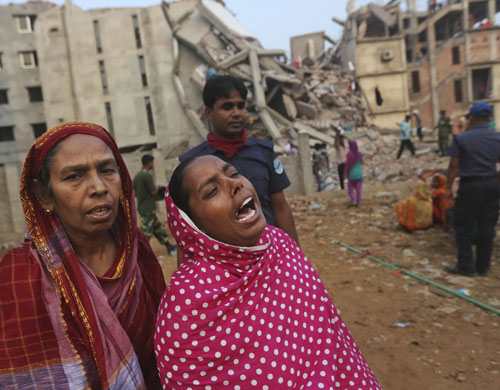
April 26, 2013, Savar, Bangladesh. Relatives of garment workers who worked in the collapsed eight-story building that housed five garment factories. Photo: AP
On April 24, 2013, at least 3,500 workers were in the Rana Plaza complex in Savar, Bangladesh, that housed five garment factories. When it collapsed, hundreds died instantly; others lived a few, last horrifying hours or days in a concrete tomb. More than 600 died and hundreds are still missing. Over 2,500 were rescued, many maimed for life, losing their arms and legs.
This was not an accident. This was a crime of a criminal system.
The day before the collapse, workers had reported massive cracks in the walls and refused to go in. But the next day the owners said the building had been inspected and declared safe and ordered the workers back in, threatening them with the loss of a month's pay if they refused. Less than an hour later the top floor buckled, leading to what is ranked as the second most deadly building collapse in modern times after 9/11. The factory owners and managers who ordered the workers in; the engineers who declared the building safe; the political authorities who turned a blind eye to the construction of this death trap—all have blood on their hands.
But if you really want to know why this nightmare happened, and why things like this keep happening, again and again, in Bangladesh, in China, in Mexico, even in the U.S., you have to follow the trail of blood and money from the ruins of the factory, through the sprawling slums in which the workers live, all the way to the gleaming corporate towers of the imperialist world—in New York, in London, in Tokyo, in Paris. Here is where you will find what is at work that leads to and is the cause of such deadly human disasters.
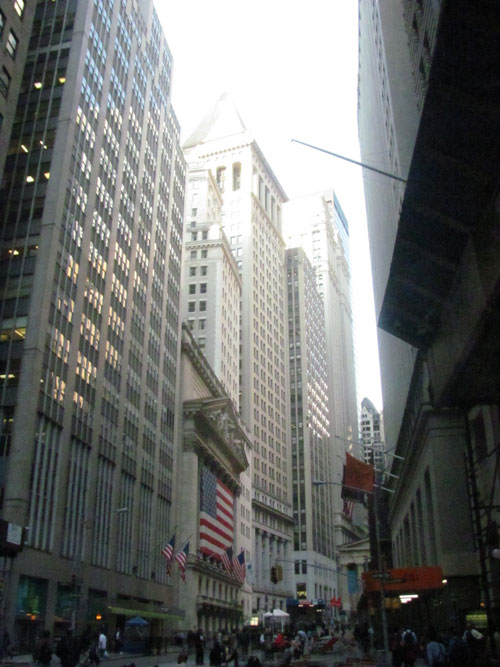
Wall Street, New York City
Photo: Special to Revolution
Through slavery, robbery, war, and the grinding exploitation of laboring people, unimaginable wealth has been accumulated by the imperialists. Trillions of dollars are commanded by a small number of huge banks and investment houses in a few wealthy countries. But this accumulated capital is restless. There is intense competition between different blocs of capital and between different imperialist powers, and in this competition even the biggest capitalists can be crushed and ruined, the most powerful empires can crumble. Competing capitalists are driven to go out into the world and find new and more profitable outlets for investment, and to beat out their rivals who aim to do the same. Whether they make clothing or iPhones or luxury cars, whether in England or India or Mexico, is irrelevant to capital—the "product" it is concerned with is profit itself. In pursuit of profit they have enmeshed hundreds of millions in a worldwide net of endless, mind-numbing, back-breaking, and dangerous work. Workers must sell their labor power—their ability to work—in order to survive. And in return for their survival wage (or less), these workers generate even more profit to expand existing capital, to enable it to reach ever wider and ensnare and destroy ever more people.
Especially in the Third World, extremely low wages, child labor, repression of the people, no building or safety codes, and corrupt and pliable local governments are in fact the necessary conditions for profitable imperialist investment, and even a modest improvement in wages and conditions can lead the imperialists to pull up stakes and move somewhere else where people are even more desperate, where conditions are even worse. This is a basic rule of the way capitalism functions and can only function.

Walmart store in the United States. Photo: AP
The shelves and racks of brightly patterned clothes, the endless choices for shoppers in cities like New York and Paris, come drenched in the blood of millions of women and children around the world who make the clothes in slave-like conditions.
Clothing is a trillion-dollar-a-year industry, a source of enormous profit, and is built on nightmarish exploitation in the Third World. Bangladesh is a major part of this—3.6 million workers in approximately 4,500 factories generating $20 billion a year in production. Bangladesh has the lowest cost of labor in the world. The national minimum wage is 21 cents an hour, or $38 a month—less than $500 if you work all year. Attempts to organize real unions are brutally suppressed—last year a well-known labor activist was tortured and killed, most likely for trying to organize garment workers.
Bangladeshi capitalists may own these factories and take their cut, but the terms are being set, and the main profits reaped, by imperialist capital, which demands the cheapest possible production under threat of simply shifting their investments to another country. When more than a dozen of the world's largest clothing brands and retailers met in 2011 to discuss working conditions in Bangladesh, Walmart (as well as the Gap) refused to sign on to improving safety conditions. A Walmart representative said: "[I]n most cases very extensive and costly modifications would need to be undertaken... It is not financially feasible for the brands to make such investments."
Even now, garment production is leaving the miserable sweatshops of China for the even worse conditions of Bangladesh.
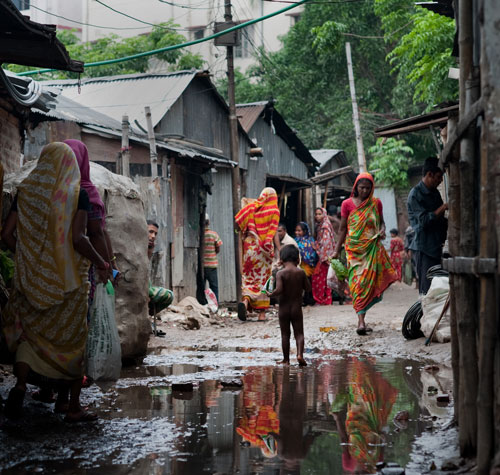
Slum in Dhaka, capital of Bangladesh, 2012. Photo: AP
The "appeal" of countries like Bangladesh to imperialist capital is the desperation of huge numbers of people. In many Third World countries, peasant agriculture has been systematically undercut and destroyed by the penetration of imperialist capital—leading to many people flooding the cities in search of work.
In Bangladesh, every three minutes a family from the rural areas moves to the capital city, Dhaka. Conditions in the countryside are increasingly difficult and people come looking for a better life, searching for jobs, a way to feed their children and provide them with clothes. Most of them end up in the growing slums around Dhaka, often in hovels of plastic and cardboard without running water or sewage or electricity. The women come to work in the garment factories, where they know the work will be hard and long, but with hopes and dreams that this will lead to a better life. But once there, the reality is different—working 14 hours a day, seven days a week, with no rights. The victims in Savar were mostly young women 18 to 25 years old, mostly unmarried, newly married, or with one or two children under 5 years old. The dead body of one garment worker was found with a small piece of paper in her hand. She wrote, "Mama and papa, please forgive me. I will not be able to buy medicine for you anymore. Brother, can you look after mama and papa?" (Farida Akhter, CommonDreams.org, April 29, 2013)
Bangladesh's garment industry produces goods worth $20 billion annually; average wages for its 3.5 million workers are about $50/month. These are superprofits, and while some of this goes to the various Bangladeshi operatives, the bulk of it flows into the networks of imperialist capital.
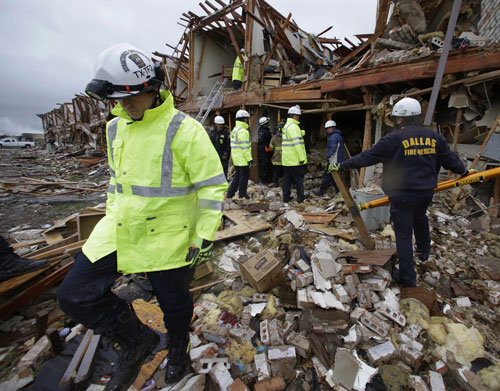
Apartment building destroyed by an explosion at a nearby fertilizer plant in West, Texas, April 18, 2013. Photo: AP
In Bangladesh there have been three major industrial incidents in the last five months, including the Tazreen Fashion factory fire in November that killed 112 people.
Such human disasters, such crimes of this system of capitalism, are in fact not unique or even unusual. Cold, calculated disregard for the lives of people, and the inevitable toll in daily suffering and death, have been part of capitalism from its birth hundreds of years ago and continue up to today.
March 1911, New York City, 146 garment workers, mainly young women, die in the Triangle Shirtwaist Factory fire. Employers had locked the exits to prevent unauthorized breaks. September 1986, Kinross South Africa, 177 miners die in a gold mine explosion set off by chemicals banned for use in Europe; between 1900 and 1993, 69,000 South Africans died and over a million were injured in the mines. November 2005, Heilongjiang Province, China, 171 coal miners die in an explosion in the Dongfeng mine; in 2008, 3,000 Chinese coal miners died in mine accidents. December 1984, Bhopal India, a Union Carbide chemical plant in a crowded shantytown leaks deadly gas that poisons 500,000 people, killing 10,000-15,000. September 1991, Hamlet, North Carolina, fire breaks out in a chicken processing plant where workers are locked in—25 killed, 55 injured. April 2010, the Gulf of Mexico, a British Petroleum-run oil rig blows up, killing 11 rig workers and dumping 210 million gallons of oil into the gulf's fragile ecosystem. September 2012, Reynosa, Mexico, explosion at the Pemex oil refinery kills 30 and injures 46. April 2013, West, Texas, a facility storing highly volatile fertilizer blows up, killing 15, injuring 160, and damaging 150 buildings, including an elementary school and an apartment building.
Such horror will continue as long as people are forced to work and live under this system of capitalism-imperialism, which must and can only operate according to the rules of capital chasing after the highest profit. No amount of reforms, good intentions, unions, or supposed "corporate responsibility" is going to change this. There never has been and there never will be a way to organize capitalist production that puts the safety and well-being of human beings ahead of the demand for profit.
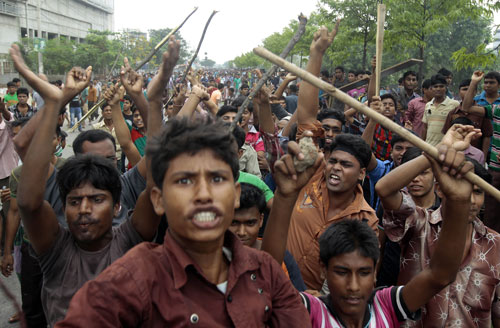
Dhaka, Bangladesh, April 27, 2013. Garment workers block a road during a protest after the collapse of an eight-story building that housed five garment factories. Photo: AP
Intense grief, anger, and rage have erupted into days of protest. Factories have been forced to close, workers have gone on strike, demonstrators have smashed and burned cars. The police have attacked people with tear gas and rubber bullets. On May Day, workers marched in the capital of Dhaka demanding safe working conditions and capital punishment for the building's owner. From the back of a truck, a relative said through a loudspeaker: "My brother has died. My sister has died. Their blood will not be valueless."
The hundreds of thousands in Bangladesh protesting this tragedy are sending a message to the rest of the world that this is intolerable. And indeed, this human disaster cries out for revolution, and nothing less, a revolution to get rid of the whole system responsible for the death of the workers in Savar—and the misery of millions of people all over the world.
* * *
For more, see “400 Garment Workers Die in Building Collapse—What Created the Concrete Tombs in Bangladesh?” and “Bangladesh: The Human Cost of Cheap Clothes.”
If you like this article, subscribe, donate to and sustain Revolution newspaper.
